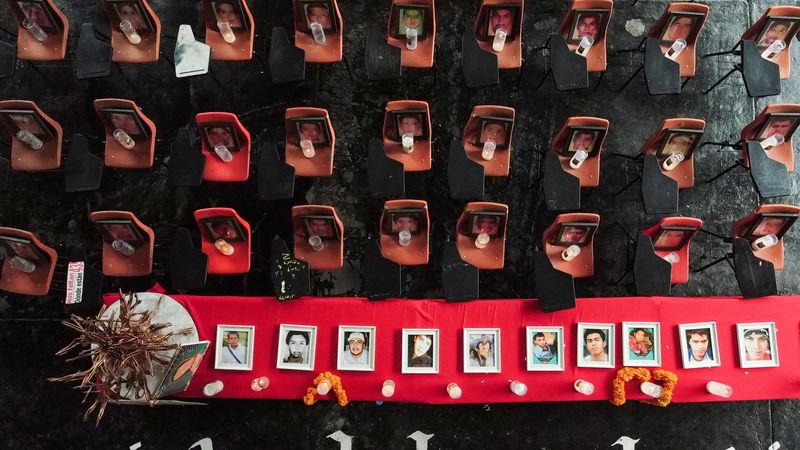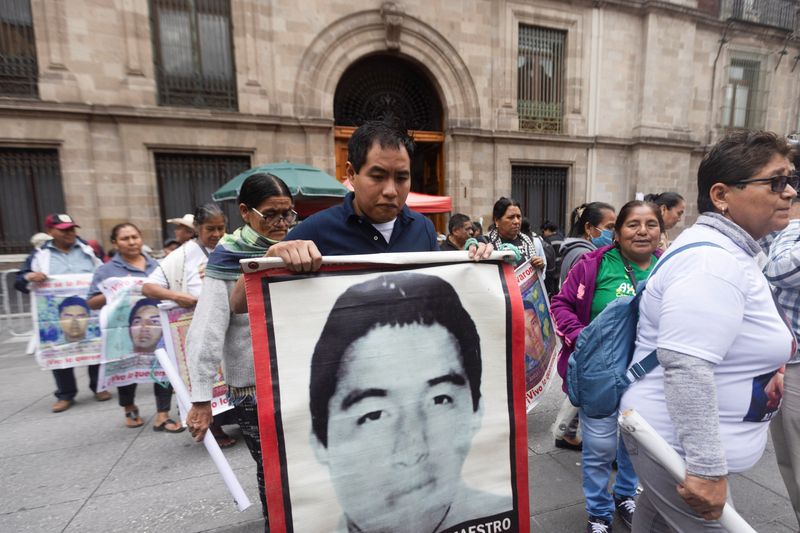By Lizbeth Diaz
MEXICO CITY (Reuters) - Ten years ago, Edgar Vargas' life forever changed when he was shot in the face in one of Mexico's most notorious cases of mass violence in recent memory: the attack and disappearance of 43 students from the rural teacher-training school of Ayotzinapa.
A bullet pierced Vargas' jaw on the night of Sept. 26, 2014, as he tried to help his classmates trapped in a bus being shot at by gunmen. Vargas, then 19, survived by crawling along the road until he found shelter, though he was left with deep physical and emotional scars.
"I knew that nothing would ever be the same again... I could hardly look at myself in a mirror," Vargas, who has undergone seven surgeries, said through tears in an interview with Reuters.
"I couldn't (speak), I saw my body full of tubes inside my mouth, of cables, it was very hard."
Vargas, now a teacher, is part of a group of survivors who have since scattered across Mexico, many of them saying they have been threatened by organized crime members and government officials, warning them to stop discussing and protesting or face unspecified consequences along with their family members.
Despite fear and trauma, some say they want to continue to seek truth and justice that has eluded them for a decade.
Every anniversary is a painful reminder of the assault on more than 100 student teachers from Ayotzinapa, in the city of Iguala in the violent state of Guerrero, some 220 kilometers (135 miles) south of Mexico City.
The students were traveling in several buses en route to Mexico City to remember the 1968 student massacre there when they were shot at. Forty three of them were then kidnapped by organized crime members who colluded with local police, according to two separate international probes, including one backed by the Organization of American States (OAS).
The motive for the attack remains a mystery.
In its initial findings, the previous government concluded the 43 had been kidnapped by corrupt police in cahoots with a local drug gang who believed the students had been infiltrated by members of a rival outfit. The gang then killed the students and burned their bodies, their report said.
The administration of President Andres Manuel Lopez Obrador, who took power in 2018, has described the disappearances as a "state crime" that authorities had tried to cover up. No one has been convicted in relation to the incident and authorities have only managed to identify remains of three of the students.
UNFULFILLED PROMISES
Families of the disappeared are still clamoring for the truth, clinging ever more skeptically to the government's promises to find the young people or get to the bottom of what happened.
President-elect Claudia Sheinbaum, who will take office on Oct. 1, has promised the investigations will continue into the incident that occurred during the mandate of then-President Enrique Peña Nieto, who was criticized by international investigators and victims' families for bringing about an abrupt closure of the case.
Peña accepted the assertion by his attorney general's office that the students' bodies had been burned on a pyre. But that was later rejected by international investigators, including the Interdisciplinary Group of Independent Experts (GIEI), a panel set up by the Inter-American Commission on Human Rights.
Many family members are also disappointed by Obrador, who had promised to resolve the case. The outgoing president has defended the armed forces, who have been accused of playing a role in the events by the foreign investigators and lawyers for the parents of the victims.
The military has denied that any of its members participated directly and says it has provided information for the investigations.
'BLOOD-STAINED SQUARE'
In 2022, a government official said there was no evidence the 43 young people were alive and declared the case a state crime. But survivors still hope their companions may have lived.
Two survivors told Reuters they had received threats telling them to stop speaking about the case. They said that officials had offered them money or lifelong jobs as teachers in public schools if they would agree not to take part in protests.
Reuters was not able to verify the alleged threats or offers.
"I was not going to accept a teaching position stained with blood," said one of the interviewees, who asked to remain anonymous and who said he had had to flee Guerrero.
Some prefer to stay away from the spotlight, but are still frustrated by the lack of justice.

"We see the rottenness of the Mexican justice system," said Aquilino Florencio, who was there that night and is now studying for a master's degree in Social Anthropology.
"I am still missing everyone, I do not feel complete."
